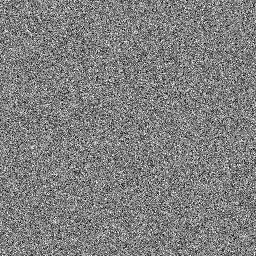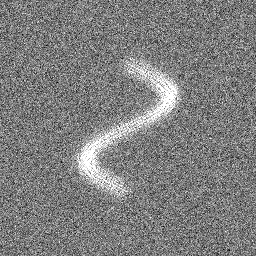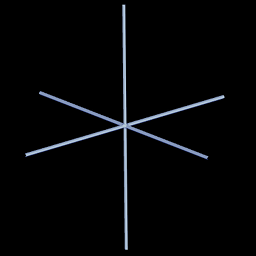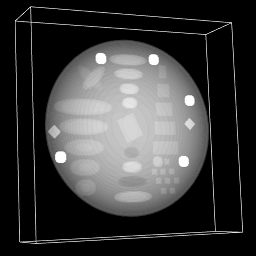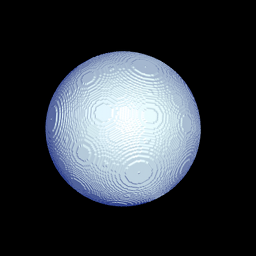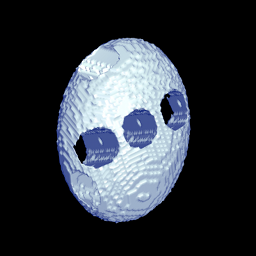|
Size: 43
Comment:
|
Size: 3883
Comment:
|
| Deletions are marked like this. | Additions are marked like this. |
| Line 1: | Line 1: |
| Describe EMAN2/Galleries/Testimages here. | <<TableOfContents>> = Python test images = EMAN2 includes a good selection of test images. They come in many shapes and forms, from simple gradients and shapes to basic noise models. == test_image (2D) == At present there are 10 2D test images that are accessible using the test_image function, which is defined in EMAN2.py. {{{ #] e2.py Welcome to EMAN2 Prompt provided by IPython Enter '?' for ipython help In [3]: e = test_image(0,size=(256,256)) In [4]: display(e) }}} If you don't specify the size argument the returned image is 128x128. The following table shows each of the currently defined test_images. ||<:>{{attachment:test_0.png}} ||<:>{{attachment:test_1.png}}|| ||<:>{{{test_image(0)}}}: The EMAN scurve ||<:> {{{test_image(1)}}}: Gaussian noise || ||<:>{{attachment:test_2.png}} ||<:>{{attachment:test_3.png}}|| ||<:>{{{test_image(2)}}}: Dark square ||<:>{{{test_image(3)}}}: Light square || ||<:>{{attachment:test_4.png}} ||<:>{{attachment:test_5.png}}|| ||<:>{{{test_image(4)}}}: Scurve and random frequency line wave ||<:>{{{test_image(5)}}}: Axes || ||<:>{{attachment:test_6.png}} ||<:>{{attachment:test_7.png}}|| ||<:>{{{test_image(6)}}}: Random frequency line wave ||<:>{{{test_image(7)}}}: Scurve and directional gradient || ||<:>{{attachment:test_8.png}} ||<:>{{attachment:test_9.png}}|| ||<:>{{{test_image(8)}}}: Randomly rotated and translated scurve ||<:>{{{test_image(9)}}}: Scurve and Gaussian noise || == test_image_3d (3D) == At present there are 6 3D test images that are accessible using the test_image_3d function, which is defined in EMAN2.py. {{{ #] e2.py Welcome to EMAN2 Prompt provided by IPython Enter '?' for ipython help In [3]: e = test_image_3d(0) In [4]: display(e) }}} The following table shows the currently available 3D test images. ||<:>{{attachment:test_3d_0.png}} ||<:>{{attachment:test_3d_1.png}}|| ||<:>{{{test_image_3d(0)}}}: Axes ||<:>{{{test_image_3d(1)}}}: Spherical waves || ||<:>{{attachment:test_3d_2.png}} ||<:>{{attachment:test_3d_3.png}}|| ||<:>{{{test_image_3d(2)}}}: Tomography test image ||<:>{{{test_image_3d(3)}}}: Solid cube || ||<:>{{attachment:test_3d_4.png}} ||<:>{{attachment:test_3d_5.png}} || ||<:>{{{test_image_3d(4)}}}: Solid sphere ||<:>{{{test_image_3d(5)}}}: Rotated ellipse with holes || = Using the processor framework = == 2D == To create a test image using the processor framework start by running e2.py and by creating an empty image that is appropriately sized, for example as follows: {{{ #] e2.py Welcome to EMAN2 Prompt provided by IPython Enter '?' for ipython help In [3]: e = EMData() In [4]: e.set_size(256,256) }}} Then issue one of the commands shown below in the table to generate the test image ||<:>{{attachment:xcoord.png}} ||<:>{{attachment:ycoord.png}}|| ||{{{ e.process_inplace("testimage.gradient")}}}||{{{ e.process_inplace("testimage.gradient", {'axis','y'}) }}}|| ||<:>{{attachment:axes.png}}||<:>{{attachment:circle.png}} || ||{{{ e.process_inplace("testimage.axes")}}}||{{{ e.process_inplace("testimage.circlesphere") }}}|| ||<:>{{attachment:scurve.png}}||<:>{{attachment:gaussnoise_large.png}}|| ||{{{ e.process_inplace("testimage.scurve")}}}||{{{ e.process_inplace("testimage.noise.gauss") }}}|| Note that this is not all of the test images, and that you can get a complete list by typying ''e2help.py processors'' on the command prompt (or see http://blake.bcm.edu/eman2/processors.html). Finally, you can display the image {{{ In [5]: e.process_inplace("testimage.scurve") In [6]: display(e) }}} You can write the image to disk if you need to: {{{ In [7]: e.write_image("scurve.img") In [8]: e.write_image("scurve.mrc") }}} Also, a great many of the test images work on 3D (and 1D) images, so feel free to play around. |
Python test images
EMAN2 includes a good selection of test images. They come in many shapes and forms, from simple gradients and shapes to basic noise models.
test_image (2D)
At present there are 10 2D test images that are accessible using the test_image function, which is defined in EMAN2.py.
#] e2.py Welcome to EMAN2 Prompt provided by IPython Enter '?' for ipython help In [3]: e = test_image(0,size=(256,256)) In [4]: display(e)
If you don't specify the size argument the returned image is 128x128. The following table shows each of the currently defined test_images.
|
|
test_image(0): The EMAN scurve |
test_image(1): Gaussian noise |
|
|
test_image(2): Dark square |
test_image(3): Light square |
|
|
test_image(4): Scurve and random frequency line wave |
test_image(5): Axes |
|
|
test_image(6): Random frequency line wave |
test_image(7): Scurve and directional gradient |
|
|
test_image(8): Randomly rotated and translated scurve |
test_image(9): Scurve and Gaussian noise |
test_image_3d (3D)
At present there are 6 3D test images that are accessible using the test_image_3d function, which is defined in EMAN2.py.
#] e2.py Welcome to EMAN2 Prompt provided by IPython Enter '?' for ipython help In [3]: e = test_image_3d(0) In [4]: display(e)
The following table shows the currently available 3D test images.
|
|
test_image_3d(0): Axes |
test_image_3d(1): Spherical waves |
|
|
test_image_3d(2): Tomography test image |
test_image_3d(3): Solid cube |
|
|
test_image_3d(4): Solid sphere |
test_image_3d(5): Rotated ellipse with holes |
Using the processor framework
2D
To create a test image using the processor framework start by running e2.py and by creating an empty image that is appropriately sized, for example as follows:
#] e2.py Welcome to EMAN2 Prompt provided by IPython Enter '?' for ipython help In [3]: e = EMData() In [4]: e.set_size(256,256)
Then issue one of the commands shown below in the table to generate the test image
|
|
e.process_inplace("testimage.gradient") |
e.process_inplace("testimage.gradient", {'axis','y'}) |
|
|
e.process_inplace("testimage.axes") |
e.process_inplace("testimage.circlesphere") |
|
|
e.process_inplace("testimage.scurve") |
e.process_inplace("testimage.noise.gauss") |
Note that this is not all of the test images, and that you can get a complete list by typying e2help.py processors on the command prompt (or see http://blake.bcm.edu/eman2/processors.html). Finally, you can display the image
In [5]: e.process_inplace("testimage.scurve")
In [6]: display(e)You can write the image to disk if you need to:
In [7]: e.write_image("scurve.img")
In [8]: e.write_image("scurve.mrc")Also, a great many of the test images work on 3D (and 1D) images, so feel free to play around.


